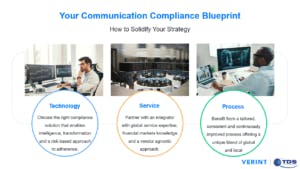Your Communication Compliance Blueprint for 2021 and Beyond: A Financial Services Perspective


2020 was no ordinary year—a year that impacted our personal lives and turned the global economy upside down.
From a business perspective, one of the major side effects of the pandemic crisis was a massive shift to work from anywhere, driving an exponential surge in communication and collaboration technology adoption. It made Zoom fatigue not only a real phenomenon but also a signature symptom of the COVID era.
With distributed working now prevailing, it’s no surprise that—especially in regulated environments—senior management concerns around risk, governance and internal controls have come to the fore.
Firms must be prepared to manage new sources of risk in a hybrid working model: just 4% expect their firms to require traders to return to in-house trading desks every day after the pandemic. All of this as they cope with budget and resource constraints, accelerate their moves to digital and the cloud, and stay competitive in the market.

The importance of compliance in overall business strategy has trended upward in recent years. It has now further accelerated, moving the needle toward building a compliance culture and protecting a firm’s reputation instead of purely safeguarding the organization against non-compliance fines and penalties.
Dealing with the COVID-Effect
According to a 2020 global compliance study [i] by Greenwich Associates and Nasdaq that was conducted after the first lockdown, 74% of senior compliance professionals strongly agreed that their firm considered compliance incredibly important, representing an all-time high and a considerable uptick from the previous year.
This significant rise in the importance of compliance, on the sell-side and buy-side alike, is understandable when we look at how businesses were forced to weather the perfect storm by switching to a more dispersed work environment, ensure operational continuity, maintain proper governance, and protect their reputation in a highly volatile market landscape.
Although financial market participants were offered temporary relief of compliance , regulators have not been sitting on their laurels. They imposed $10.4 billion in global fines and penalties on financial firms—up 27% from last year—related to anti-money laundering (AML), know your customer (KYC), data privacy, and MiFID regulations in 2020 based on a recent analysis by Fenergo.[ii]

Regulators across the globe have repeatedly warned banks that they expect the same standard of compliance monitoring of staff when working from home as they would in an office environment. The UK’s Financial Conduct Authority, for instance, recently published a Market Watch reminding bankers to record all communications (including voice calls) when working from home, ending the leeway it introduced during the first.
As economies adjust to the new normal, it is believed that regulators are likely to carry out a retrospective assessment to see if firms followed compliance procedures and maintained good conduct during the pandemic.
WFH: New Ways of Communication Create New Risks
Financial services firms, especially those that are involved in trading activity and provide services related to financial instruments, have been shifting toward the latest generation of voice and electronic communication technology over the past decade. Yet, the lockdown caught the industry by surprise—in many cases, businesses had to make snap decisions to deploy unified communications, collaboration tools and cloud-based soft clients to ensure their staff could continue to operate when working from home.
On the other hand, many businesses found out that their existing compliance infrastructure did not support collaboration, video conferencing, messaging and mobility endpoints that had been used previously for occasional remote working.
Now, as financial services firms are in the process of reassessing and re-calibrating their overall communication compliance strategy, they should have a critical view of their underlying infrastructure.
They should opt for communication compliance technology that can best support their business needs as their organization evolves, as well as choose the right partner to implement and support it to make sure they can confidently and compliantly operate in the collaboration economy—and enable them to transform and evolve in line with the ever-increasing regulations.
According to a recent study by Redlap Consulting,[iii] 70% of sell-side and 53% of buy-side respondents are planning to increase their investment in technology to address industry changes because of the pandemic. One focus area has been establishing seamless and secure lines of communication for distributed teams. And it is not surprising at all: 41% of buy-side respondents saw a rise in external communication challenges, often due to difficulties in reaching sell-side counterparts.

Internal and external communications have quickly shifted to digital collaboration and messaging apps to enable research analysts to speak to clients, help traders to provide a risk price or ensure portfolio managers can liaise with the dealing desks. Yet, the risk and compliance implications of the increased use of Zoom, Webex, Slack, Microsoft Teams, WhatsApp and other communication channels are often underestimated.
Moreover, the recent surge in the use of the encrypted messaging app alternatives, such as Signal and its rival Telegram, among bankers, traders and portfolio managers has created a surveillance blind spot for compliance workers globally.
A Blueprint to Your Communication Compliance Strategy
Financial institutions, one of the most regulated market verticals subject to strict voice and electronic communication recordkeeping and monitoring demands, have been facing demanding—and often opposite—pressure to remain in compliance by ensuring orderly trading behaviours and continuing to run their business at the same time. When it came to maintaining and monitoring communication streams and employee behaviour, all organizations had to adapt—one way or another.
Larger companies were typically slower to respond, and some had problems adjusting to the new, changing conditions. Today, the time for quick fix solutions is far behind us.
Does that mean all organizations are prepared for the era of long-term remote collaboration and hybrid working from a risk perspective? Not really. Preparedness looks different for each organization. The adoption of compliance technology must be a means to an end – adherence to regulations, good governance, operational oversight, cost reduction and risk management – rather than an end in itself.
Instead of leaning on temporary measures, businesses should think strategically and have a comprehensive review of their current communications and collaboration environments and, more importantly, implement a defensible, risk-based and compliant voice and eComms strategy.
- Choose the Right Technology
The compliance requirement of regulators around the globe is now clearly shifting away from a certain level of regulatory relief (taking all reasonable steps to maintain controls), toward the expectation that market participants will meet all of their regulatory obligations, including the requirement to record all communications by regulated users—no matter where they are located.
Businesses have been enthusiastically adopting some of latest unified communications and collaboration tools in order to better enable remote working. But there is a growing realization that existing communication compliance technology solutions often do not meet minimum compliance standards for recording and monitoring the variety of communication features offered by these platforms.

When considering a rollout of Teams, Symphony, Zoom, Webex, softphones, messaging apps or other virtual clients for traders, portfolio managers, research teams and other support staff in the back office, businesses need to take a critical view of their embedded recording and compliance technology capabilities. In doing so, there are several questions to answer:
- Are existing solutions able to support video conferencing, channel-based persistent chat rooms, attachments, file transfers and shared screens alongside voice, chat and other traditional means of interaction?
- Is it possible to make sense of the increased volume of recorded voice recordings, which are the most complex to structure, interpret and extract relevant data from?
- Do existing solutions offer a cohesive and holistic view across the array of interaction streams occurring, with both internal colleagues and external parties?
- Does the recording infrastructure come with appropriate sizing capabilities to support the increased volume of remote working?
- To what extent is the system extendable to cover remote users?
- Is my solution ready to support a user-based licensing model, given the diversity of platforms a user may use for interactions, information sharing and collaboration on a daily basis?
- And does it provide open, bi-directional integrations to surveillance and analytics, so that they can ingest recorded interaction streams and advanced metadata for broader contextual intelligence around what was said, shared, typed or shown during a transaction?
Behind all the buzz, only a few technology providers have started to seriously address these challenges to empower firms to manage risk and maintain compliance in this changing and evolving landscape. Communication compliance technology in the post-COVID reality shouldn’t limit its perspective to channels to be captured and monitored to retain and retrieve evidence of how an order or trade evolved.
Instead, it will require a human-centric approach to compliance: an individual may use different channels to interact and trade, may perform regulated activities from different locations, and may be subject to an evolving fabric of regulations and policies.
Growing regulatory expectation pushes firms toward establishing capture and surveillance that is more aligned around the human and that is risk-based in the first place—rather than focusing on a communication stream to be captured, the quality of a voice call to be monitored, or conversations to be monitored for anomalies.
- Embrace Seamless Integration Services
As more and more businesses are looking to migrate their current communications environment or implement entirely new collaboration platforms to establish reliable and more flexible lines of communication during and beyond the pandemic, it has become imperative to have a compliance infrastructure in place that supports adherence, cost effectiveness and sufficient flexibility in the long term.
However, any technology change should be aligned with a best practice and an expert service integrator to avoid the extensive and resourcing headaches of implementation, lifecycle management and complex data migrations.

Especially considering the plethora of tools businesses have been adopting to become more productive and enable their teams to interact in real time, compliantly unifying and consolidating the management and accessibility of legacy communication records can be a real challenge.
Particularly at large, global enterprise companies including banks, investment firms and asset managers, a change in communication technology may imply the need to harmonize an often siloed compliance infrastructure—and provides an opportunity to rethink their overall data strategy.
Partnering with the right integrator with deep service expertise, financial markets knowledge and a vendor-agnostic approach is key to helping to ensure a smooth compliance technology migration and implementation. It is not only about ease the deployment and make the data transformation process more cost-effective. It is also about empowering businesses to get the most out of their technology, manage change and provide assurance as their business evolves.
The voice and electronic communication recording environment is often fragmented across different recording vendors and multiple data silos, let alone an array of proprietary formats and codecs. Therefore, key data lifecycle events such as large-scale migrations to a unified estate for data management, discovery and playback can be cumbersome and pose significant risks from an accessibility, governance and regulatory compliance standpoint.
Of course, there is no ‘one-size-fits-all’ to manage technology and data transformations as each organization has its own unique challenges. Consequently, businesses are looking at a risk-based approach that aims to understand business operations, the legacy technology and the underlying risk exposures with actual risk identification and management, as well as the outsourcing to expert teams to properly manage the process.
- Leverage a Tailored and Consistent Process
As compliance requirements for voice and electronic communications record-keeping and monitoring are expanding, so do the need to manage legacy, electronically stored data in a harmonized way—and the complexity of adopting new technology within global operations.
The technology you choose is as critical as the partner who implements it. However, the importance of the process is often underestimated.
When considering a move to a new compliance technology vendor, financial firms should take a comprehensive approach to the compliance silos, and lean on a trusted advisor who understands the process, tooling and technology in order to deliver a high level of assurance across the platform.
This is where customer service excellence and end-to-end system support should go hand in hand with a global reach, consistent operating models and a local approach to provide the best expert assistance—ranging from installation to continued maintenance and support of the communication compliance technology as a whole.
In essence, the role of process is really about working with the partner that can overlay an agile and sustainable process on top of the implemented tools to help ensure the overall infrastructure is working as required.
Verint and Trusted Data Solutions: A Leading Partnership for Successful Communication Compliance Transformations
The partnership between Verint and Trusted Data Solutions (TDS) gives your business the golden combination of technology, services and process to set the foundations for a sustainable, cost-effective and innovative compliance strategy.
It was born with the vision to bring the right compliance tools, integration services and a proven process to help financial market participants meet regulatory obligations and maintain an infrastructure that facilitates compliance.
The partnership already enables global investment banks, asset managers and other leading financial firms to combine integrated communication compliance solutions with specialized managed services and support for large-scale voice and electronic communications data migration, implementation, transformation and assurance.

Verint’s secure and reliable compliance recording, data governance, analysis and operational monitoring capabilities supporting the latest UC, collaboration, trader voice, mobile and telephony environments are underpinned by TDS’ end-to-end system support including voice and eComms compliance technology migration, implementation, and data lifecycle management. This spans comprehensive and vetted services covering project management, inventory management, installation and testing, server migrations, maintenance and support.
Our joint expertise and technology leadership in the compliance arena helps enable businesses to not only reduce the risks of communication technology change programs, but also benefit from specialized engineering processes and proven techniques to the communication compliance environment.
By partnering with Verint and TDS, businesses can lean on a harmonized approach to communication and collaboration compliance via broad financial markets industry domain expertise and highly specialized managed services to support risk, compliance, and IT teams in all phases of the voice and electronic communications compliance data lifecycle.
Overall, we provide financial services firms with a bespoke, cost-effective way to help them meet regulatory obligations using advanced regulatory technology, industry-standard tooling elements and reliable and consistent service support to help them meet increasing regulatory demands they face under MiFID II, MAR, Dodd-Frank and other evolving regulatory obligations.
[i] Greenwich Associates – NASDAQ, Global Compliance Survey, November 2020.
[ii] Fenergo, Up Close and Personal – The Year of Personal Accountability – Global Research Report on Financial Institution and Individual Enforcement Actions in 2020, December 2020.
[iii] ‘Challenges in communication with brokers rise for buy-side, survey finds’ The Trade News, February 9, 2021.